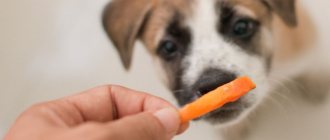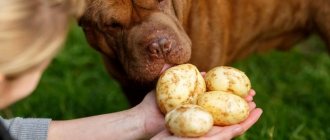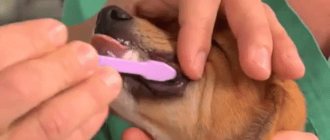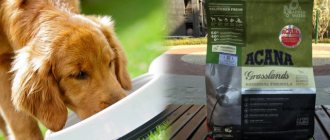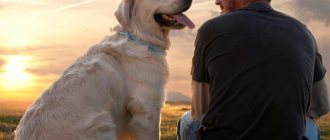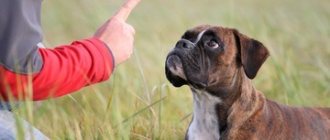Weight standards for dogs of different breeds
Representatives of different breeds of dogs differ from each other in size, body composition and, accordingly, weight values, therefore, before making a decision on fattening an animal, it is important to study the concept of the norm specifically for it. Examples of normal weight for adult dogs of popular breeds are given in the table:
| Breed name | Normal weight value (in kg) |
| Rottweiler | 39–47 |
| German Shepherd | 28,5–36 |
| Doberman | 28–39 |
| Labrador | 30–36 |
| Boxer | 29–34 |
| German dog | 70–90 |
| Dachshund | 9–10 |
| Chihuahua | 1–2 kg |
| Yorkshire Terrier | 2,3–2,6 |
Natural changes in these indicators are influenced by pregnancy and the period of feeding offspring in females, the period of growing up of puppies and increased stress during the dog’s work with a low-calorie diet. If the calculation of feeding rates is carried out taking into account the age, characteristics of keeping and use of the pet, but its weight is rapidly decreasing and cannot increase in any way, it is worth examining the animal at the veterinarian for the presence of hidden internal diseases and disorders.
Symptoms and signs of pet exhaustion
When looking at an emaciated dog, its body weight deficit becomes noticeable to the naked eye. Such animals have clearly visible ribs, a strongly retracted belly and faded, often disheveled fur. The pet itself becomes lethargic and apathetic, losing more and more strength every day. If this condition is not typical for dogs at the genetic level (for example, it is relevant for greyhounds), it is worth reviewing the feeding and care regimen for your pet, paying special attention to veterinary care and the calorie content of the products used in feeding.
Why doesn't my dog gain weight?
If the dog eats well, but stubbornly does not gain weight, the cause of the problem may be a helminthic infestation, which is often found among street stray animals. By driving away the worms, it is possible to solve the problem, although only if the pet does not have concomitant disorders. Cachexia is often one of the main symptoms of the following ailments:
- chronic and acute renal failure;
- hepatitis A;
- hepatosis;
- cholecystitis;
- cholestasis;
- inflammatory processes in the oral cavity and digestive system.
Did you know? The fattest dog in the Guinness Book of Records is a border collie named Cassie. Her weight at the time of registration was 58 kg, which is almost three times the norm for dogs of this breed.
In addition, weight loss often occurs against the background of poisoning, viral and bacterial diseases, hormonal and autoimmune diseases, but in any case, the problem can be eliminated only after a comprehensive examination and a course of appropriate therapy.
Other causes of exhaustion include:
- the birth of more than 10 puppies in females and their prolonged feeding;
- advanced age of the pet and refusal of food due to deterioration of health;
- postoperative period or rehabilitation period after suffering a serious illness;
- prolonged lack of food and wandering of the animal;
- breed tendency towards thinness (relevant for many hound dog breeds).
In mild cases of cachexia, proper nutrition alone may be sufficient, but in severe cases, the animal is given food only after a course of maintenance therapy and always in small portions.
Reasons why dogs may lose weight
Not every owner has the opportunity to visit a veterinarian to undergo an examination and identify the problem, so it is possible to determine the options for weight loss using the following parameters:
- Perhaps the dog is feeding its own offspring? This means you need to pay special attention to nutrition, because as puppies grow, they begin to take more important substances from the mother’s body, thereby she begins to lose her own weight and underfeed the puppies.
- If a dog, in addition to weight loss, notices vomiting and poor appetite, it is likely that the dog may become the owner of worms. And they, as a rule, devour important elements of the body, thereby depleting it. It is urgent to start taking special medications, but before that, visit a veterinarian.
- There is such a disease as “dysbacteriosis”, if undigested food remains are noticed in the dog’s feces, then the cause is this disease. To treat it, there is a course of drugs, you need to visit a veterinarian.
- If the dog is young, then you should not fatten him, this can cause problems. Dogs often have an active metabolism and, therefore, gain weight no earlier than by 2 – 2.5 years.
- The reason may be that the dog is malnourished; to make sure that the owner is feeding the dog, you need to refer to special tables that indicate the required weight of the dog by gender and breed. Thanks to it, you can understand what weight is needed and how much the dog is behind or exceeding the indicators.
Nutrition after illness or surgery
The characteristics of a dog’s diet after undergoing surgery depend on the type of manipulation performed. For example, for some gastroenterological problems, during the operation a probe is installed in the animal, which irritates the mucous membrane of the esophagus and other organs of the digestive system. In this case, solid dry food will only aggravate the discomfort and inflammation of the irritated surface, so it is better to replace it with liquid or semi-liquid food, perhaps even for syringe feeding. Small dogs can be held in your hands while feeding, and for the convenience of feeding larger dogs, you can use stands.
As for the composition of the feed, in the postoperative period animals are often recommended a diet with a high fat content, which allows them to receive enough energy without overloading the digestive system. However, based on the root cause of the existing disorder, the veterinarian may recommend a low-fat diet, thereby preventing possible disruption of the digestive processes and constipation in the pet.
Did you know? The average bite force of a dog is 155 kg, while humans can bite with a force of 55 kg, and crocodiles can bite with a force of 1135 kg.
The simplest and most useful solution for a dog to the problem of complete nutrition in case of severe exhaustion is the use of ready-made recovery food, since it is designed specifically for weakened pets and does not have a negative effect on the weakened digestive system.
With a natural diet, the menu should be based on the use of easily digestible products: on the first day you can give the animal only chicken broth and rice water, gradually adding the cereal itself. Introducing fermented milk products and probiotics into the diet (for example, “Viyo Recuperation”) will help protect the digestive system from constipation.
Weight gain on natural food
It is quite difficult to achieve the most positive results in a dog’s weight gain using cereals or meat alone, but with the right combination of them, taking into account a suitable feeding scheme, everything is possible. The owner only needs to choose the most suitable healthy ingredients for each meal of his four-legged friend.
Cereals for weight gain
In the first days of recovery of the dog’s body, it is best to prepare meat porridge based on well-cooked rice, possibly pureed in a blender. After about 2-3 days, oatmeal is gradually added to the rice, and after another week, buckwheat can be included in the diet. It is better to leave wheat and egg grains until the pet has fully recovered and its stomach has become stronger. In any case, porridge should make up no more than 20–30% of the daily food volume for an emaciated animal, since the main place in the special menu is occupied by well-cooked lean meat (for example, chicken or rabbit, as well as steamed vegetables. For the elderly and small pets are allowed to prepare food in the form of purees, mixing cereals, meat and vegetables.
What not to give
Many owners try to normalize the condition of an exhausted dog by including fatty foods and high-calorie flour products in its diet, without thinking about the difficulty of digesting them in the pet’s digestive system. Pork, lamb and homemade fatty chicken may well cause constipation and liver problems, so it is better to give a weakened animal turkey, beef, veal and rabbit. The meat component for the fattening period should be represented by meat, and not by-products, which contain much less protein. As soon as the pet begins to recover, as an exception, it is allowed to introduce pate from boiled beef liver and vegetables into the diet (you can make it at home). As for healthy dogs, prohibited foods that cannot be introduced into the diet under any pretext were and remain:
- smoked products (even if it is meat);
- raw pork and fish;
- flour and sweet products, especially chocolate;
- legumes;
- bones in any form;
- citrus fruits, raisins and fresh grapes.
If in the first weeks of therapeutic nutrition the dog shows interest in raw vegetables, they should not be given yet. Some healthy individuals with normal body weight are happy to eat raw carrots or even cucumbers, but for a weakened body they can be dangerous foods.
Did you know? The average bite force of a dog is 155 kg, while humans can bite with a force of 55 kg, and crocodiles can bite with a force of 1135 kg.
Mode and serving size
Increasing the calorie content of the food consumed by the dog should be done gradually, because a sudden load on a weakened stomach is dangerous to health: the intestinal balance is disrupted and diarrhea may occur. To begin with, the volume of the usual portion is increased by 10% and, if the pet is feeling well, after 2-3 days the daily calorie content of the food is increased by another 10%, continuing this process until the desired normal weight level. As soon as daily weighing of the dog confirms the success of all actions, you can gradually reduce the number of calories in the food given to the dog.
On average, an emaciated animal is fed 6–8 times a day in small portions, but after a week you can reduce the frequency to 4–5 times a day. In severe cases, normal nutrition is replaced by intravenous infusion of nutrient solutions, since even a small amount of natural products or dry food can kill the animal.
Nutrition for malnourished dogs
The diet must be balanced
Now it’s worth moving directly to the question of what to feed an emaciated dog to gain weight.
One of the main rules is small portions. You cannot give food like a healthy animal twice a day in large portions. No, in order to properly feed a pet, it needs to be given food 7-8 times a day, but little by little.
It is best to use natural food - here the person knows exactly what he is feeding the dog, and does not rely on the honesty of the dry food manufacturer. Moreover, the diet should contain a lot (about 70%) of meat to restore muscle mass. It is best to take low-fat and easily digestible varieties, such as chicken and rabbit.
The remaining 30% should be divided between cereals and vegetables - approximately 20-25 and 5-10%, respectively. It is best to choose rice and buckwheat from cereals, and carrots, zucchini and pumpkin from vegetables.
Attention! The porridge is cooked in meat broth (the proportion is 1 cup of cereal to 4-5 cups of liquid), the vegetables are chopped and mixed with it and meat. The result is a nourishing, tasty and healthy mixture.
Weight gain on dry food
Special lines of dry food for weight gain by an emaciated dog are the best solution to this problem. The owner does not have to think about what kind of food and in what quantity should be given to the dog, and all that is needed is simply to calculate the daily weight of the finished food in accordance with the current condition of the pet.
The most popular types of such therapeutic nutrition include the following options for ready-made feed mixtures:
- Royal Canin Gastro Intestinal Dog. It is often used during the recovery period after illnesses and for anorexia in dogs. Contains rice, degenerative poultry proteins, egg powder, beet pulp, corn, animal fats. The constituent components ensure ease of digestion of the prepared food, without causing any negative consequences of its use on the part of the animal’s digestive system. The manufacturer produces dietary products for 20 different breeds, taking into account the individual characteristics of different dogs and their living conditions. Experts consider one of the significant disadvantages of this food to be the high content of ingredients of plant origin.
- Britcare. The main advantage of this premium food is the high content of meat as a source of protein and rice as a source of carbohydrates. Compared to wheat and corn, it is digested much better and does not cause food allergies in dogs prone to it. The disadvantage of this food is its low fiber content (only 2.5%).
- Happy dog Supreme Sport. A good solution for a balanced diet not only for sick and malnourished dogs, but also for animals facing daily physical stress. Poultry, rice flour and corn present in the food help replenish wasted energy and improve the overall well-being of the pet. According to the manufacturer, flavorings, food colors and preservatives are completely absent. At the same time, he did not indicate which types of meat were used in the production of this food, which, together with the high cost, is considered the main disadvantages of this option.
- Hill's Science Plan. In comparison with previous options, the undeniable advantages of this particular food are its low cost and high content of vitamins and minerals, although the exact amount of meat is not reported. Also of concern is the presence of corn and wheat as the main ingredients of ready-made food, and as you know, it is these cereals that are considered a serious allergen.
Important! You should not save on your pet’s health by buying cheap dry food from unknown companies. Ideally, you should choose food only after consulting a veterinarian, based on the dog’s current condition.
Failure to digest food, what to do
At the initial stages of rehabilitation, it is not recommended to feed an emaciated dog dry food. The optimal consistency of food is liquid or semi-liquid, because it is in this form that a weakened stomach absorbs it best. Problems with digestion usually occur when:
- excessive feeding of the animal;
- food intolerance to any constituent ingredients of food products;
- rapid swallowing of the offered food;
- spoilage of products;
- high content of cereals and lack of meat in the composition;
- helminthic infestations.
The main sign of a problem is vomiting, indigestion and the release of almost the entire amount of food eaten. In severe cases, body temperature may increase. Reviewing its diet and replacing the selected food mixture with a lighter option will help improve your pet’s well-being. You need to feed the dog in very small pieces, trying to prevent the swallowing of air along with the food.
Dosage of dry food when gaining weight
At first glance, everything seems extremely simple: in order for a dog to gain weight, you just need to increase the amount of food given, especially since the packaging of the finished product already contains manufacturer’s recommendations in this regard. However, if in some cases you can simply adhere to the upper limits of the noted norm, then in case of a large weight deficit, it is worth adding another 10–30% to this value, distributing the additional amount of granules between all feedings. If the resulting volume of food for a particular animal turns out to be too much, you can simply replace the standard feed mixture with a higher-calorie product: for example, food intended for growing puppies, pregnant or lactating bitches. To correctly measure the appropriate amount of food, it is advisable to use a special measuring cup, which is often included with the food itself.
Important! By increasing the caloric content of food, you should not limit physical activity. In the first weeks after the start of treatment, the animal does not have much strength, but in the future it is useful for him to walk, swim or even run.
The correct method of fattening the pasture
- If the dog is very thin, it needs to be fed many times a day, three to four times. Also, by feeding this way, the dog will digest food better and will be able to eat more of it.
- There are high-energy feeds that help in fattening; the methods for using them are indicated in the instructions or on the packaging; you must follow them.
- It is possible that the dog is tired of eating the same thing; it is necessary to replace the food, for example, with canned food or other types of food of higher quality. You can also switch to natural food, the main thing is not to combine it with regular food, this is prohibited.
- It is necessary to monitor vitamins such as B and B12; they are usually found in beef and eggs. They are very important for the dog's body, especially when gaining additional weight.
- Calorie counting is also necessary; dogs should receive different amounts of calories per 1 kg of weight; the larger the dog, the more calories are needed. For example, a small dog should receive 86 kcal, and a large dog should receive around 62 kcal.
You can’t start feeding your dog suddenly; you need to gradually increase the portions, otherwise you can harm the animal. The most important thing is not to “break” the metabolism; weight gain and weight loss require special attention, both in animals and in people.
Weight gain due to muscle growth
With every day of proper nutrition, the dog will gain weight, but whether it will turn into excess fat over time largely depends on physical exercise with the pet. Increased muscle mass provides the dog with better strength and endurance, making him active and cheerful. This is especially true for sled dogs and guard dogs, not to mention representatives of service breeds. Special training will help keep your pet in good physical shape.
Exercises
To maintain the dog's good physical shape, no extra effort is required on the part of the owner; the main thing is to pay enough attention to the pet during the next walk. The most useful exercises while spending time together in the fresh air will be:
- Run. Jogging behind a bicycle or just jogging allows you to use all muscle groups, while simultaneously activating better functioning of the dog’s internal organs.
- Swimming is a universal exercise that will keep absolutely any pet in good physical shape. The back muscles are used best during swimming, although the load on the paws is no less noticeable.
- Jumping and overcoming barriers. In this case, the dog actively engages those muscles that were ignored during previous exercises. The main point is that the obstacles should not be very high and the surface should not be slippery, otherwise there is a risk of injury to the animal’s joints.
- Walking on steps. The development of leg muscles always plays an important role in the life of any animal, improving the coordination of its movements. If the dog periodically climbs the stairs, this will help strengthen the skeletal muscles and the entire musculoskeletal system as a whole.
As an additional type of physical activity, you can consider games with fellow tribesmen, which allow you to combine a pleasant pastime for the dog with benefits for its body. The enthusiasm and increased activity of relatives awakens in the pet an unbridled desire for fun, while performing certain exercises at the command of the owner is not always accepted by the animal with a bang.
Vitamins for weight gain
In addition to a properly formulated diet, special vitamins can also help an exhausted dog gain weight. A pet's body always needs nutrients, many of which are not found in the animal's usual food. If the main goal is to gain weight for your pet by increasing muscle mass (the most acceptable option), then it is better to give preference to the following vitamin complexes:
- "Wolmar". The drug contains 18 amino acids, 12 vitamins and minerals that have a beneficial effect on the growth of muscle cells. The main task of this vitamin supplement is to activate protein synthesis in muscle tissue, which allows you to increase the total muscle mass, and therefore the weight of the animal. In addition, vitamins supply the dog’s body with the energy the pet needs during increased physical activity.
- "Protevit plus" - vitamins recommended to prevent metabolic disorders in the body. The drug contains protein, potassium, magnesium, linoleic acid, vitamin C, K, and a protein metabolism stimulator. All these components have a beneficial effect on all processes in the dog’s body, increasing the performance and endurance of the pet.
As in the case of the optimal food mixture, only a doctor can suggest the ideal type of vitamin supplements for a particular dog, based on the pet’s condition and the presence of any concomitant diseases.
We advise you to read more about the meaning and criteria for choosing vitamins for dogs.
How to avoid weight problems in Yorkies?
To prevent your Yorkie from becoming obese , you need to monitor his diet. You can feed your pet dry food, specialized ready-made canned food, or food you prepare yourself. Dry food has many advantages:
- it contains all the vitamins and microelements necessary for dogs;
- it does not need to be prepared, which saves time and is very convenient when traveling;
- feed manufacturers produce products suitable for a specific breed.
Despite the above advantages, dry food also has disadvantages. Eating this way can lead to stomach problems. If you feed your pet dry food, always make sure he has fresh water.
An alternative to this food can be ready-made canned food.
Canned food is, of course, quick, tasty and convenient, but can lead to the formation of tartar, which can be recognized by bad breath. You can prepare food for your Yorkie yourself. At the same time, make sure that your pet does not eat spicy, fatty or sweet foods. Forbidden for Yorkies are raw river fish, sausages, sausages and smoked meats, white bread and legumes. Yorkshire Terriers must eat raw or boiled beef, vegetables, cottage cheese, dairy products, and egg yolk. Special vitamin supplements must be added to your Yorkie's self-prepared food.
To make your pet feel good, organize a diet for him. Adult Yorkies over ten months of age should eat twice a day. In the first two months of life, puppies are fed six times a day, at 3-4 months - five times, at 5-6 months - four times, at 7-9 months - three times a day. You can read more about how to feed Yorkshire Terrier puppies in this article.
A properly organized regimen and diet for your Yorkie will be the key to his good health and well-being.
